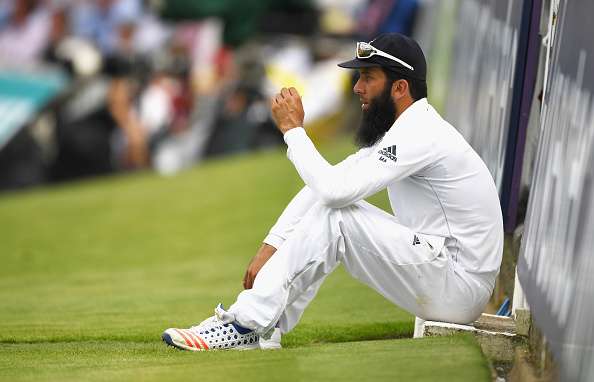The recent heat wave should have had spinners all over England loosening their fingers. Even a few days of 90-degree weather is enough to dry and loosen pitches enough to make them more friable and helpful to spin, a state of affairs all too rare in English conditions these days despite global warming.
Tweakers need the right conditions to encourage them, most obviously a pitch that allows the ball to grip on a fullish length.
If they don’t get them, and generally they don’t now that most county squares are made of loam soils, the modern evils of smaller boundaries and chunky bats that pick up like feathers, make them a luxury affordable only to captains whose sides make big totals of 400 plus.
English spin bowling has been in something of a crisis since Graeme Swann retired suddenly in 2013. Since then, England have made do mostly with Moeen Ali, though there have been others: Adil Rashid, summoned to the squad for the Old Trafford Test against Pakistan, Simon Kerrigan and Scott Borthwick have also had a twirl.
None are yet top-class, something that became glaringly obvious in the first Test at Lord’s when Ali was utterly outbowled by Yasir Shah, Pakistan’s wrist-spinner.
England’s batsmen must shoulder some of the blame for making Yasir look better than he was, especially in the home side’s first innings when the ball did not really spin.
But Moeen needs to become more durable and not so easily hit off his length, which is what Misbah-ul-Haq did to him. After all, he won’t often get three left-arm seamers creating a big area of rough for him outside the right-handers’ off stump, and he should have exploited the situation far better than he did.
Not that Cook could afford to give him a long bowl in the second innings when the rough was at its most helpful. England, suffering a 69-run deficit on first innings, simply did not have enough runs to play with.
The lack of world-class spinners coming through from county cricket is nothing new. Incentives to encourage the twirlymen have been around a long time.
Obviously the latest, dispensing with the toss in the hope that pitches will start dry, produce decent totals and then turn as the game progresses, have to be given time. Yet others have been introduced then removed with indecent haste.
Those that I can recall began with the re-introduction of uncovered pitches for the 1987 season. Part of Derek Underwood’s primacy as a spin bowler during his career was due to the havoc that he wreaked on pitches doused by rain but which were then rendered tacky when they dried (the old sticky dogs of yore). Until pitches were covered in 1981, he and several other spinners held sway, though not in 1987. On that occasion, pitches may not have been covered but the bowlers’ run-ups were, which allowed seamers a secure footing leaving spinners to play their customary support role.
Canned after one season, thedirective was replaced in 1988 by the first four-day matches, though not all County Championship games were made so until the 1993 season.
Four-day cricket, the argument ran, would allow sides to bat for longer and rack up bigger totals, which would then allow spinners to bowl more. Trouble was, because games were going longer, pitches were built to last longer too, with the use of loam soils over the local ones.
Loam dries and rolls hard, with the only wear and tear being cracks which tended to help the seamers more than spinners by producing variable bounce. They certainly didn’t crumble or dust, which is what usually enables a ball to turn.
In 1988, the season which saw four-day cricket partially introduced, 14 spin bowlers sent down at least 500 overs. In 1998 only two did and in 2008 three spinners bowled that number of overs, evidence surely that the four-day game has not been their saviour.
Then there was the smaller-seamed Duke ball (11 strands of twine used), brought in for the 1990 first-class season as a response to the big-seamed Reader ball of 1989 (15 strands of twine), which rarely lost its shape, shine, or nip, at least not long enough to consider more than the odd over of spin.
In a classic bit of wire-crossing that season, the Test and County Cricket Board also instructed counties to prepare straw-coloured pitches.
Most experiments see one variable changed not two, but not in 1990. The result, runs flowed and by May 7 there had been 32 hundreds including two triples and seven doubles.
Bowlers’ averages rose alarmingly and while most found themselves under the cosh, it was spinners who tended to be the costlier option. Once again, they found themselves under-utilised in an environment meant to encourage them.
That experiment lasted one season, too, which makes the latest encouragement for spinners, the removal of the toss for visiting teams who wish to field first, a must for a prolonged roll out. So far, and it is mid-July, the evidence that spinners have been suitably encouraged is thin with only Jeetan Patel, a New Zealander anyway, having taken more than 30 first-class wickets.
My solution would be to allow all bowers to follow-through down the pitch thus roughing up areas in line with the stumps on a good length.
The umpires would be present to police over abuse, but with the current law-makers almost all batsmen, there is little chance of it being introduced.
Then there is the lack of specialist spin coaches at all levels of the game to consider, something Peter Such, the ECB’s national spin coach, is trying to remedy.
Mind you, once you reach the county game, spinners need to learn the craft and psychology by competing in matches, not sweating in the nets.
Factor in also that batsmen are now bolder against spin and play it better, generally, than was the case 20 years ago (England’s batsmen at Lord’s excepted), and it is a big task for Such and his team.
For that, and in propagating spin and the wonderful variation to cricket that it brings, we wish them well.
This piece originally featured in The Cricket Paper, Friday July 22 2016
Subscribe to the digital edition of The Cricket Paper here












